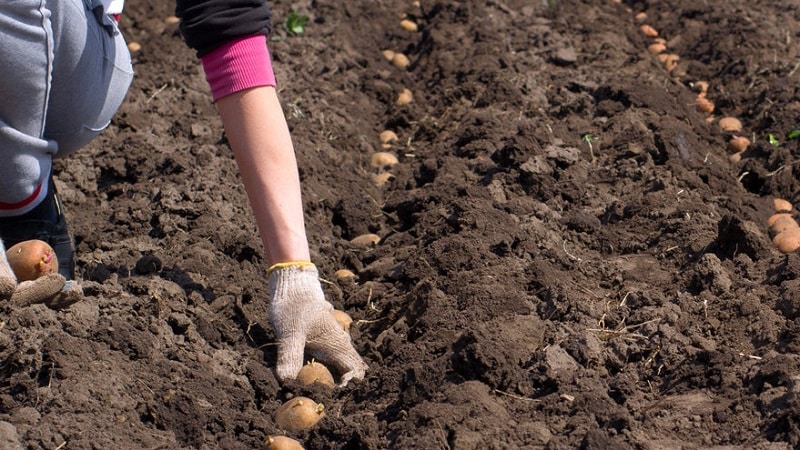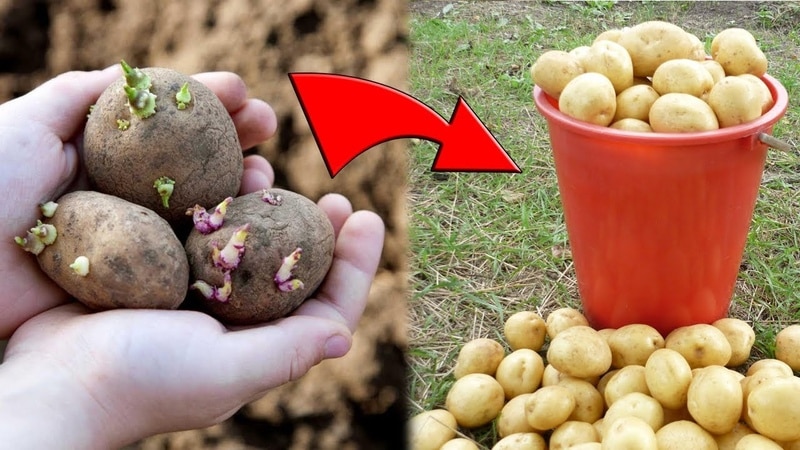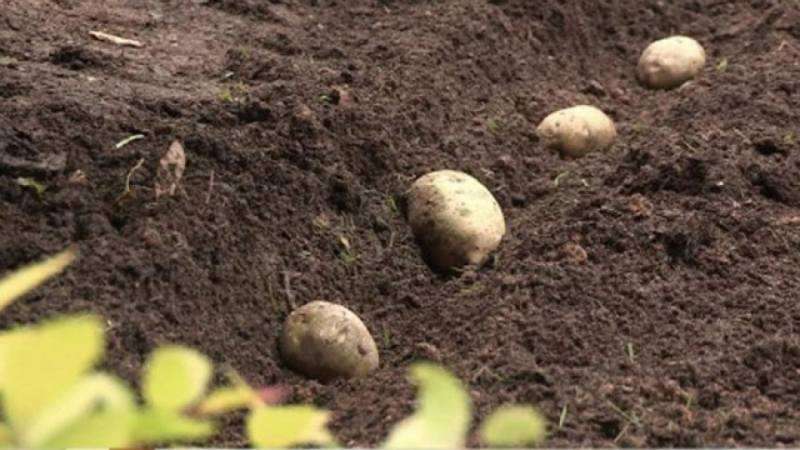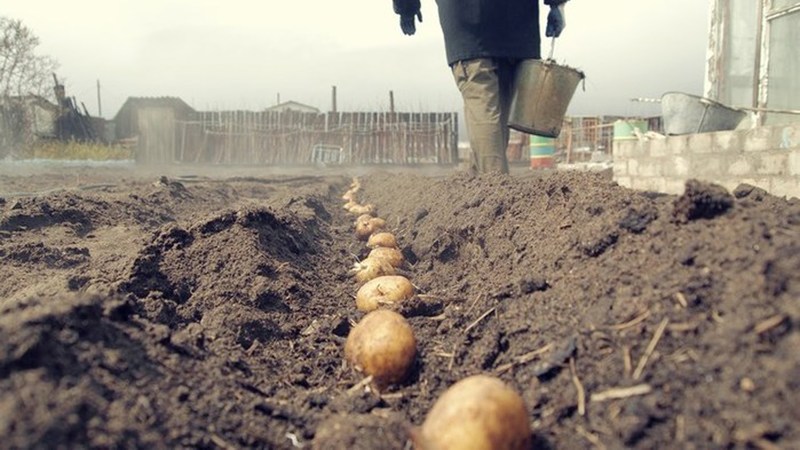Proper planting of potatoes before winter: step-by-step instructions for beginning gardeners
Traditionally, potatoes are planted in the spring. But those who forget unharvested vegetables in the furrows observe good shoots in the spring. Planting potatoes before winter allows you to get an earlier and more abundant harvest. For this growing method, choose a suitable one variety, properly prepare the beds and planting material, and care for the plants.
Is it possible to plant potatoes before winter?
Most potato varieties are adapted to the fact that they are planted in the spring, cared for in the summer, and harvested in the fall. It is also possible to plant the crop in late autumn: such vegetables will hatch earlier.

Advantages and disadvantages
Advantages of autumn planting:
- accelerated ripening - potatoes sprout earlier than those planted in the usual way, their growing season is longer, the crop ripens faster;
- high yield - tubers overwintered in the ground produce more powerful shoots;
- protection from diseases and pests - such plantings will be “out of touch” with most diseases and insects.
The main disadvantages of the method:
- In severe winters with little snow, all seed potatoes die;
- if the site is chosen incorrectly and melt water stagnates on it, the tubers will become soaked in the ground and will not sprout;
- the usual method of adding organic matter, when compost or manure is scattered in the fall, and plants are planted in the spring, is not applicable - the soil will be poorer;
- the consumption of planting material increases - winter crops are not germinated, so it will not be possible to cull in advance tubers that do not germinate and are damaged by wireworms.
The bulk of the potatoes are saved for spring planting, and a test plot is planted in the fall. It will ripen faster than even early-ripening varieties, and the vegetables will be ready for harvest almost a month earlier.
Choosing the right variety

For effective winter growing of potatoes, choose mid-early and late varieties:
Super early varieties (Nevsky, Gala, Zhukovsky early) are not suitable for planting before winter. They will begin to grow before frost and die in the winter without producing a harvest. The main thing with this growing method is that the sprouts should not sprout before frost, so as not to die entirely.
Important! It is better to use varieties zoned for a specific subject of the Russian Federation.
Regions for winter cultivation
Favorable conditions for winter planting:
- moderate frosts: not lower than -30…-35°C;
- heavy snow: if the snow cover is 10–15 cm or higher, do not worry about frost;
- early or moderately late melting: exact dates are determined in accordance with the climate of a particular region, the snow should melt completely when the bed warms up to +5°C at a depth of 10 cm.
The southern and central regions of Russia and the Caucasus are suitable for winter planting. The difference between Kuban and the Moscow region is only in the timing of cultivation. It is more difficult in the Northwestern region and the Southern Urals, where spring is delayed. In the Northern Urals and central regions of Siberia, tubers freeze in winter, and sprouts die during a thaw.
Landing dates
Specific dates depend on the region and climatic conditions:
- Middle zone, including the Moscow region - mid-October.If the temperature does not drop below -10°C, then potatoes are planted until December.
- South - November.
- North - focus on freezing ground. If frost occurs at night, but the soil thaws in the morning, the crop is still planted.
Preparing the beds
When planting before winter, prepare the site as in spring. It is dug up or plowed, furrows are cut or holes are dug. In addition to the rules of crop rotation, winds and the degree of heating under direct rays of the sun are taken into account, so shading the beds is unacceptable.
A site protected from north and northeast winds and located on a hill is well suited. Here the earth will warm up faster in the spring, and excess meltwater will drain into the lowlands.
Preparation of planting material

Tubers are selected according to the following parameters:
- Weight - at least 90 g, optimally - 100-150 g or more. It is important for potatoes to overwinter, retaining enough nutrients for germination in the spring - the heavier the tubers, the more viable they will be. Unlike spring planting material, for which medium-sized vegetables are selected in the fall, the largest potatoes are used for winter planting.
- No traces of diseases, pests or damage. Potatoes cut with a shovel can sprout in the spring, but if planted before winter, they will not live to see it.
- Lack of sprouts. Such tubers will quickly begin to grow and die. They are only “greened” by laying them out in direct sunlight two weeks before planting.
Landing instructions
Classic scheme for planting winter potatoes:
- Beds are formed on the prepared plot.
- Holes are dug in a checkerboard pattern. Compost or humus is laid out at the bottom of each; straw manure can also be added.This is both feeding and protection from freezing: rotting organic matter releases heat. The holes are cut at a distance of 70 cm between rows and at least 30 cm from each other.
- Tubers are planted in the holes. In this case, the seeding rate increases by at least 10–15% compared to spring planting.
- The vegetables are covered with earth, the plot is covered with branches of deciduous trees or spruce branches. Lay a 30 cm thick layer of straw or hay on top. Mulch the beds well with peat or humus (about 10 cm thick).
The second option is “planting in hay”:
- In August they begin to prepare the plot: the grass is mowed and laid in an even layer within the boundaries of the plot with a tolerance of 50 cm beyond the boundaries of the future bed. This will protect the potatoes from freezing.
- In September, the procedure is repeated; hay from other hay fields is brought to the garden bed. As a result, a “pillow” approximately 30 cm thick is formed.
- Select and green the potatoes until the skin is light green.
- Using a crowbar or a pointed stake, individual holes are formed for each potato. The diameter of the hole is equal to the size of the tuber. Holes are dug through the hay in a checkerboard pattern about a meter apart, but no closer than 50 cm from the edge of the hay.
- Add 1 tbsp to each hole. ash and 1 liter of fertile soil or humus.
- Potatoes are planted and covered with fertile soil in a 3 cm layer.
- The holes in the hay “cushion” are plugged with pre-prepared scraps of hay or straw.
- The entire structure is left for the winter.
At what depth to plant
The choice of planting depth depends on the type of soil on the site and how cold winters usually are in the region. It is important to remember two factors:
- Shallowly planted potatoes will freeze in winter even under a layer of hay.
- Deeply planted tubers will not germinate or will germinate late, resulting in the loss of all the benefits of winter growing.
Optimal planting depth options:
- in heavy chernozems and clay soils - 10–15 cm;
- in sand and sandy loam - 20–25 cm.
Further care

Before the snow falls, the beds do not need maintenance. In winter, especially if it is frosty, the plantings are covered with an additional layer of snow, spreading it from neighboring areas. Sometimes snow retention is carried out by placing shields so that they slow down the drifting snow and form a snowdrift over the planted potatoes.
In the spring, when the temperature rises above zero, the mulch is removed from the beds. If only organic matter is used, it is left in its original place: it will rot, enriching the soil with organic matter, but while it retains its structure, it will suppress weed seedlings. Unharvested synthetics suppress the sprouting of the potatoes themselves.
As soon as the first shoots appear, they are earthed up. Early weeds are carefully removed. If cold temperatures and frosts are expected, the plants are watered with water at room temperature.
Important! Since mole crickets, beetles and wireworms become active in the spring, the area is treated with Bazudin, Aktara and other drugs in the dosage prescribed by the manufacturer.
The soil is regularly loosened. This can be combined with weeding and hilling, or done separately.
If necessary, planted potatoes are watered in spring and summer.
Advice from experienced gardeners
Farmers who grow potatoes in the winter method recommend taking into account some nuances:
- Growing dates are strictly observed, but early planting is more dangerous than late planting. If there is an urgent need, potatoes can be buried even in frozen soil, but if the tubers begin to sprout and sprout, the plants will die.
- Like spring potatoes, winter potatoes need additional feeding. It is carried out three times per season: at the beginning of tops growth, flowering and for the formation of tubers. Use a solution of superphosphate, urea and potassium sulfate (20 g of active substance per 1 m2 of bed). Fertilizers are applied only to moist soil.
- In addition to fertilizing with mineral fertilizers, in the spring they use an infusion of ash and a solution of chicken manure (1 kg per 10 liters of water). Manure is applied at the rate of 0.5 liters per plant, ash - as needed.
Reviews
Let's find out what gardeners themselves say about this method of growing potatoes.
Ekaterina, Kursk region: “This year I planted the same variety both before winter and in spring. For some reason, the plantings ripened at the same time.”
Ivan, Moscow region: “We planted potatoes before winter after that: there was no other plot. Along with the new variety, a small thing came out that had been forgotten from last season. When we dug, the harvest was noticeably higher than usual.”
Sergey, Tver region: “We planted potatoes before winter, and in another area in the spring. The winter one ripened earlier, but many of the tubers were frozen—we had to cover them better.”
Conclusion
Climate change and mild winters force gardeners to plant potatoes more often not in spring, but in autumn. Although winter planting produces the first shoots faster, which bring a rich harvest, it requires special cultivation techniques and adherence to agrotechnical rules, without which the plants will die.